DISH #4: FROZEN CAPRESE
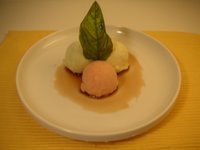 Okay, let's get this all out in the open. I know the haters are out there. There are those who think that ice cream is well enough left alone. And there's a point to be agreed on here: fancypants pizza and pickle ice-cream does not need to be made. Vanilla flavors like, well, vanilla are good in their own right.
Okay, let's get this all out in the open. I know the haters are out there. There are those who think that ice cream is well enough left alone. And there's a point to be agreed on here: fancypants pizza and pickle ice-cream does not need to be made. Vanilla flavors like, well, vanilla are good in their own right. That said, there's also something to trying new things, pushing the limit, seeing if there's potential to the lightning bolt idea that at times may be more death-strike on the golf course than Doc Brown sliding down the cable from the clocktower to save the day and send Marty and the DeLorean back to good old 1985 (by the way you can buy a rebuilt DeLorean from the base back up for a low, low price of $42,500! If I had a spare $43,000 I'd totally buy it and rock out to Huey Lewis with my state of the art AM/FM Cassette Stereo and 6 month/6,000 mile bumper to bumper warranty).
That said, there's also something to trying new things, pushing the limit, seeing if there's potential to the lightning bolt idea that at times may be more death-strike on the golf course than Doc Brown sliding down the cable from the clocktower to save the day and send Marty and the DeLorean back to good old 1985 (by the way you can buy a rebuilt DeLorean from the base back up for a low, low price of $42,500! If I had a spare $43,000 I'd totally buy it and rock out to Huey Lewis with my state of the art AM/FM Cassette Stereo and 6 month/6,000 mile bumper to bumper warranty). It's that in between place that I'm at right now with my idea for a three savory ice-cream appetizer, a reimagined mozzarella caprese, frozen if you will. I had the idea back in the first week of August and experimented with it at home. The first version (at left) was a tomato ice with a blend of mozzarella and marscapone (in an attempt to get a very creamy, almost burrata-type cream) on a slice of tomato with homemade focaccia and tampenade.
It's that in between place that I'm at right now with my idea for a three savory ice-cream appetizer, a reimagined mozzarella caprese, frozen if you will. I had the idea back in the first week of August and experimented with it at home. The first version (at left) was a tomato ice with a blend of mozzarella and marscapone (in an attempt to get a very creamy, almost burrata-type cream) on a slice of tomato with homemade focaccia and tampenade.More about this ice cream adventure on the jump...
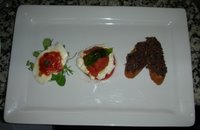 After a first attempt at home I hoped to try the dish at school, and we made it while stationed at Entremetier at L'Ecole, FCI's student restaurant, where a version of it was served with some success. I've since further developed the idea. The natural centerpiece will be a mozzarella ice cream. Why, you say? Well, have you ever had it? I haven't. Most of the skeptics are in fact, my friends, and I suppose that's what happens when you make them try a Roquefort ice cream and you mistakenly add too much of the stinky cheese to the recipe you're using from a well-known dessert expert.
After a first attempt at home I hoped to try the dish at school, and we made it while stationed at Entremetier at L'Ecole, FCI's student restaurant, where a version of it was served with some success. I've since further developed the idea. The natural centerpiece will be a mozzarella ice cream. Why, you say? Well, have you ever had it? I haven't. Most of the skeptics are in fact, my friends, and I suppose that's what happens when you make them try a Roquefort ice cream and you mistakenly add too much of the stinky cheese to the recipe you're using from a well-known dessert expert.There were cries of "it looks like vanilla but tastes like dirty socks!" Agreed, I apologize, but please, do remember the cream cheese ice cream which accompanied my carrot-pear cake. Uh-huh, that's right, a success as I recall. And in the face of skepticisum in my mind it's like when Sir Edmund Hillary said, why mozzarella ice cream, well, "because it's there." Oh, he only said that last part? Well, you get the idea.
Now I'm not completely out of my gourd here. First of all, the flavor of this ice cream will be far more subtle. There's no dirty sock possibility here. And I'm wary of how the mozzarella will dissolve into the ice cream base. Mozzarella means to cut after all and it's super stringy when warmed. I still want a creaminess so I'm going to cheat a bit; it's a Mozzarella-Marscapone Ice Cream. The mozzarella in the ice cream is homemade, not, I'm sorry to say the marscapone.
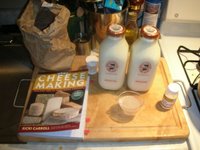 I envisioned three piles of tomatoes, each with slices of yellow and red tomatoes alternating with mozzarella cheese and atop each pile, a different ice cream scoop, one of each component of a mozzarella caprese, basil, tomato and mozzarella itself (I also considered investigating an olive oil ice cream or ice but I had my work cut out for me as it was). Thus the first step for this dish would be to make two batches of mozzarella, one for the ice cream and one for the alternating layers of tomato and cheese.
I envisioned three piles of tomatoes, each with slices of yellow and red tomatoes alternating with mozzarella cheese and atop each pile, a different ice cream scoop, one of each component of a mozzarella caprese, basil, tomato and mozzarella itself (I also considered investigating an olive oil ice cream or ice but I had my work cut out for me as it was). Thus the first step for this dish would be to make two batches of mozzarella, one for the ice cream and one for the alternating layers of tomato and cheese.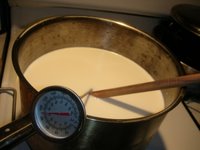 This dish took me at least a full week to complete between my other obligations-- I had to do it in several stages. For the mozzarella-marscapone ice cream I used the batch of mozzarella I made for the post, "The Cheese Stands Alone," using the recipe for 30-minute mozzarella from Home Cheese Making By Ricki Carroll.
This dish took me at least a full week to complete between my other obligations-- I had to do it in several stages. For the mozzarella-marscapone ice cream I used the batch of mozzarella I made for the post, "The Cheese Stands Alone," using the recipe for 30-minute mozzarella from Home Cheese Making By Ricki Carroll.My recipe for the mozzarella-marscapone ice cream is adapted from one from Bare Ingredients for marscapone ice cream. Of course, this isn't meant to be served by itself so I'm playing with recipes for tomato sorbet, basil and tomato sorbet, tomato ice cream, lime basil sorbet, basil ice cream
Marscapone Ice Cream
Preparation: 30 minutes
Cooking: 1 litre
Mascarpone makes a very rich ice-cream, with a thicker texture than a traditional vanilla ice-cream. This ice-cream makes an excellent accompaniment to fruit based desserts, such as poached fruits, fruit compotes, pies and fritters.
Ingredients
Vanilla Ice-Cream:
500ml milk
6 egg yolk
250g caster sugar
2 vanilla pods
500g mascarpone
Method
1. Custard: Place the milk in a sauce pan. Cut through the centre of the vanilla pods and spoon the seeds into the milk and place the pods in the milk. Place the milk over a low heat and slowly bring it to a strong simmer then remove it from the heat. Remove the pods from the milk.
2. Whisk the egg yolks and sugar together in a large bowl until pale yellow and creamy. While whisking gradually add all the hot milk.
3. Return the mixture to a saucepan and place it over a low heat, cook gently while stirring constantly with a wooden spoon until it thickens and coats the back of the spoon. Be careful not to overheat the milk as you will end up with scrambled eggs. Remove it from the heat and leave it to cool.
4. Ice-Cream: When the custard has cooled whisk in the mascarpone until well combined. Place the mixture in an ice-machine and churn it until thickened, then place in a freezer proof container and freeze until ready to serve. If you don't have an ice-cream machine place it in a freezer proof sealed container and place it in the freezer for 1 hour then remove it and stir, then return to the freezer and take it out and stir it every 30 minutes for a further 2 hours. Freeze until ready to serve.
Arturo's Mozzarella-Marscapone Ice Cream
500 ML Milk
6 Egg Yolks
10g Sugar
250 G Finely Grated Mozzarella (NOT PIZZA CHEESE, THE GOOD STUFF!)
250 G mascarpone
10 G Salt
Procedure:
1. Bring 500 ML milk to a strong simmer then remove it from the heat.
2. Whisk 6 egg yolks and 10 G sugar together in a large bowl until pale yellow and creamy. While whisking gradually add all the hot milk.
3. Return the mixture to a saucepan and place it over a low heat, cook gently while stirring constantly with a wooden spoon until it thickens and coats the back of the spoon. Don't overheat the milk and scramble the eggs. Remove from the heat. When tepid, add the base to the shredded mozarrella, then mix in the 250 G marscapone and chill in fridge.
4. Place the mixture in an ice-machine and churn it until thickened, then place in a freezer proof container and freeze until ready to serve. Freeze until ready to serve.
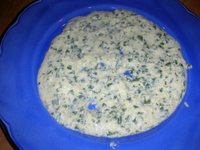 The next step, Monday, was a Basil Ice Cream. You've read about my Sunday missteps with this creation in Which Was 1st? Ice Cream Or Scrambled Eggs, but the end result was a success, a very light pale green, Sweet Basil Ice Cream. I followed a recipe from Epicurious.
The next step, Monday, was a Basil Ice Cream. You've read about my Sunday missteps with this creation in Which Was 1st? Ice Cream Or Scrambled Eggs, but the end result was a success, a very light pale green, Sweet Basil Ice Cream. I followed a recipe from Epicurious. I still needed another batch of cheese and so before starting the ice cream I went out to get some milk for the mozzarella. My local upscale grocer was out of the non-super pasteurized milk so I bought the regular stuff and went home to try my luck, simultaneously making the cheese and the ice cream.
I still needed another batch of cheese and so before starting the ice cream I went out to get some milk for the mozzarella. My local upscale grocer was out of the non-super pasteurized milk so I bought the regular stuff and went home to try my luck, simultaneously making the cheese and the ice cream.Basil Ice Cream (epicurious.com)
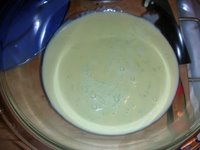 When food editor Shelley Wiseman remarked on the basil ice cream she had at JoJo, Jean-Georges Vongerichten's Manhattan bistro, other editors recalled tasting herb-flavored custards in Milan years ago.
When food editor Shelley Wiseman remarked on the basil ice cream she had at JoJo, Jean-Georges Vongerichten's Manhattan bistro, other editors recalled tasting herb-flavored custards in Milan years ago.2 cups whole milk
3 tablespoons chopped fresh basil
1/2 cup sugar
4 large egg yolks
1/2 cup well-chilled heavy cream
Special equipment: an instant-read thermometer; an ice cream maker
Bring milk, basil, 1/4 cup sugar, and a pinch of salt to a boil in a 2-quart heavy saucepan, stirring, then remove from heat and let steep 30 minutes. Transfer to a blender (reserve saucepan) and blend until basil is finely ground, about 1 minute.
Beat together yolks and remaining 1/4 cup sugar in a medium bowl with an electric mixer until thick and pale, about 1 minute. Add milk mixture in a stream, beating until combined well. Pour mixture into reserved saucepan and cook over moderate heat, stirring constantly with a wooden spoon, until mixture coats back of spoon and registers 175°F on thermometer (do not let boil). Immediately remove from heat and pour through a fine-mesh sieve into a metal bowl. Set bowl in a larger bowl of ice water and stir until cold, 10 to 15 minutes.
Stir in cream and freeze in ice cream maker. Transfer ice cream to an airtight container and put in freezer to harden, at least 2 hours.
Cooks' note:
Ice cream can be made 2 days ahead.
Makes about 3 cups.
The basil ice cream turned out just fine but the mozzarella made from the pasteurized milk was a failure. It would not set up at all. I threw it out and went to class. I decided to make the fresh mozzarella last of all for just before the shoot. The next part of this plan would be to make the tomato ice cream.
I decided to go with a tomato ice cream over a tomato sorbet for a few reasons, the sorbet recquires more sugar to make it set up and I don't want something too sweet, it can end up tasting like ketchup as did a version at school. Secondly, I began to picture the sorbet melting and its water mixing unattractively on the plate with the melted basil and mozzarella on the plate. I think the three different flavors will hold up on the plate, even melted if they are all of the same consistency, milk and cream.
I looked through several different recipes, one from RecipeSource, one from Astray, one from Recipegal.com, and one from Hub-uk.com. None of these recipes were satisfying though so I turned back to old faithful, The Ultimate Ice Cream Book. Unfortunately, the only recipe I could find that was close to what I was looking for was a Tomato Granita. But again, I feared it would be too much of an ice and would melt in a way that was unattractive. So I tried something else, adapting another recipe, one for peach ice cream. Both are fruits afterall and both are made up of a lot of water.
Peach Ice Cream (The Ultimate Ice Cream Book, By Bruce Weinstein, pps. 95-96)
Nothing beats the flavor of fresh peach ice cream. Commercially frozen peaches and canned peaches just don't have the same fresh, summer taste. So buy extra when they're at their peak; then peel, slice, and freeze your own.
3 Large, Sweet Peaches, Peeled and Pitted (About 1 1/4 Pounds)
1/4 Cup Peach Nectar
Juice of 1/2 Lemon
1/4 Teaspoon Salt
2/3 Cup Sugar 2 Large Eggs
2 Tablespoons All-Purpose Flour
1 Cup Milk
1 Cup Heavy Cream
Slice the peaches into eighths and place in a blender with the peach nectar, lemon juice, and salt. Blend until the peaches are pureed. Set aside.
In a medium mixing bowl, beat the sugar into the eggs until they are thickened and pale hellow. Beat in the flour. Set aside.
Bring the milk to a simmer in a heavy medium saucepan. Slowly beat the hot milk into the eggs and sugar. Pour the entire mixture back into the pan and place over low heat. Stir constantly with a whisk or wooden spoon until the custard thickens slightly. Be careful not to let the mixture boil or the eggs will scrable. Remove from the heat and pour the hot custard through a strainer into a large, clean bowl. Allow the custard to cool slightly, then mix in the peach puree and cream. Cover and refrigerate until cold or overnight.
Stir the chilled custard, then freeze in 1 or 2 batches in your ice cream machine according to the manufacturer's instructions. When finished, the ice cream will be soft but ready to eat. For firmer ice cream, transfer to a freezer-safe container and freeze at least 2 hours.
I cut the sugar, added an egg and increased the salt to create my recipe.
Arturo's Tomato Ice Cream
6 Tomatoes, Peeled and Seeded
Juice of 1/2 Lemon
1 Teaspoon Salt
1/2 Cup Sugar
3 Large Eggs
2 Tablespoons All-Purpose Flour
1 Cup Milk
1 Cup Heavy Cream
Place peeled and seeded tomatoes in a blender with the lemon juice, and salt. Blend until the tomatoes are pureed. Set aside.
In a medium mixing bowl, beat half the sugar (1/4 Cup) into the eggs until they are thickened and pale hellow. Beat in the flour. Set aside.
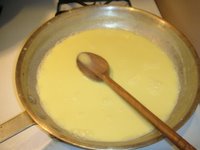 Bring the milk to a simmer in a heavy medium saucepan. Slowly beat the hot milk into the eggs and sugar. Pour the entire mixture back into the pan and place over low heat. Stir constantly with a whisk or wooden spoon until the custard thickens slightly. Be careful not to let the mixture boil or the eggs will scramble (see my previous disaster). Remove from the heat and pour the hot custard through a strainer into a large, clean bowl. Allow the custard to cool slightly, then mix in the tomato puree and cream. Use the rest of the sugar (1/4 Cup) to flavor the ice cream to taste, maintaining the balance of sugar and salt. Cover and refrigerate until cold.
Bring the milk to a simmer in a heavy medium saucepan. Slowly beat the hot milk into the eggs and sugar. Pour the entire mixture back into the pan and place over low heat. Stir constantly with a whisk or wooden spoon until the custard thickens slightly. Be careful not to let the mixture boil or the eggs will scramble (see my previous disaster). Remove from the heat and pour the hot custard through a strainer into a large, clean bowl. Allow the custard to cool slightly, then mix in the tomato puree and cream. Use the rest of the sugar (1/4 Cup) to flavor the ice cream to taste, maintaining the balance of sugar and salt. Cover and refrigerate until cold.Stir the chilled custard, then freeze in 1 or 2 batches in your ice cream machine according to the manufacturer's instructions.
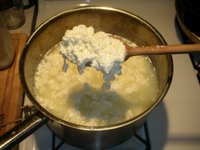 And with the completion of this ice cream there were finally just a few remaining things to do before I could plate the dish and be done with it-- one was to make the fresh mozzarella. This time I was able to get a hold of four quarts of Ronnybrook's Creamline Milk (the website claims, "Our milk is pasteurized but not homogenized so the cream floats to the top. The "Dom Perignon" of dairy according to the New York Times").
And with the completion of this ice cream there were finally just a few remaining things to do before I could plate the dish and be done with it-- one was to make the fresh mozzarella. This time I was able to get a hold of four quarts of Ronnybrook's Creamline Milk (the website claims, "Our milk is pasteurized but not homogenized so the cream floats to the top. The "Dom Perignon" of dairy according to the New York Times").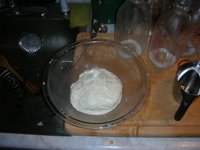 It certainly is good milk (their chocolate milk is really tasty too) and it worked wonders for the cheese-making. No issues with the cheese setting up this time. However instead of draining the cheese as thoroughly as the recipe in the book dictated I allowed it to keep some of its moisture.
It certainly is good milk (their chocolate milk is really tasty too) and it worked wonders for the cheese-making. No issues with the cheese setting up this time. However instead of draining the cheese as thoroughly as the recipe in the book dictated I allowed it to keep some of its moisture.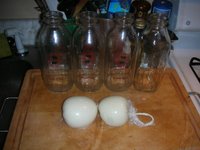 I also only microwaved it for about thirty seconds twice instead of the full minute each time. I added flaked cheese salt, wrapped it in plastic and allowed it to set. I divided the cheese in two and experimented by soaking one half in they leftover whey and allowed the other to sit out. When I tasted the cheeses hours later after class, both versions were very good. They were creamier and less dense than the first cheese I made, more like an upscale mozzarella than a pizza cheese.
I also only microwaved it for about thirty seconds twice instead of the full minute each time. I added flaked cheese salt, wrapped it in plastic and allowed it to set. I divided the cheese in two and experimented by soaking one half in they leftover whey and allowed the other to sit out. When I tasted the cheeses hours later after class, both versions were very good. They were creamier and less dense than the first cheese I made, more like an upscale mozzarella than a pizza cheese.Zoe, who works at Murray's later suggested that for better cheese the microwave could be substituted for water heated up to 180ºF and then poured over it as was done in the days before our newfangled radiation techniques.
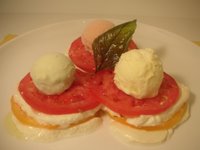 And so finally, on Friday afternoon, a week after beginning the dish, it was time to plate it. I fried up some basil leaves for garnish, sliced the tomatoes got the shoot lights going. The result is the plate at the left. I drizzled a little olive oil over each scoop and sprinkled some sea salt over it.
And so finally, on Friday afternoon, a week after beginning the dish, it was time to plate it. I fried up some basil leaves for garnish, sliced the tomatoes got the shoot lights going. The result is the plate at the left. I drizzled a little olive oil over each scoop and sprinkled some sea salt over it.I was please with the way it looked and tasted but upon further consideration I decided it was too busy.
 Instead, I replated the dish, with a light watercolor-type wash of balsamic vinegar on the beneath the scoops of ice cream. I'd considered trying to emulate the thin wafer-cracker-like WD-50 bread to add a contrasting texture to the plate but in the end I decided to let the ice creams stand on their own. Overall, I'm satisfied with the dish. If you close your eyes and taste the flavors you'll know what you're eating. If it were to be served in a restaurant, it wouldn't be anywhere near as problematic to make as it was here. The ice cream would be previously made, put in the freezer and be ready to scoop.
Instead, I replated the dish, with a light watercolor-type wash of balsamic vinegar on the beneath the scoops of ice cream. I'd considered trying to emulate the thin wafer-cracker-like WD-50 bread to add a contrasting texture to the plate but in the end I decided to let the ice creams stand on their own. Overall, I'm satisfied with the dish. If you close your eyes and taste the flavors you'll know what you're eating. If it were to be served in a restaurant, it wouldn't be anywhere near as problematic to make as it was here. The ice cream would be previously made, put in the freezer and be ready to scoop.Is it 1.21 Gigowatts? Well, I guess you'll have to come over and judge for yourself.





0 Comments:
Post a Comment
<< Home